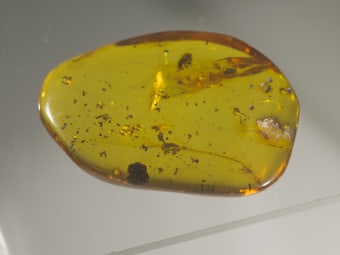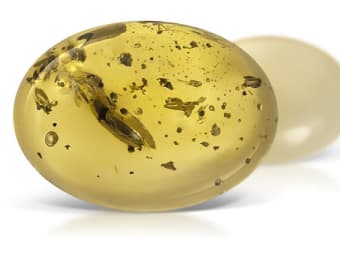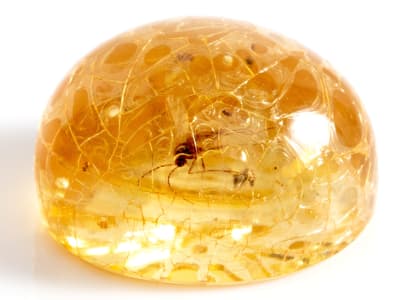Many of us think we know what amber is, but do we truly? The movie Jurassic Park brought it to attention - brought it to life, in fact, but it can be difficult to separate fact from fiction. Amber and copal belong to a category of gemstones known as the organic gems. Organic gems are those that were not formed by geological forces, but rather by those of living organisms. The best known organic gem is pearl, but coral, horn, tortoise shell, ivory and many others fall into this category too. Amber and copal are sometimes called natural resins because they form from the resins secreted by plants and trees. Pine sap is a commonly known plant resin, but pine trees are not the source of either amber or copal. Baltic amber originated from a plant that was a distant and ancient relative of the modern pine tree.
What is Baltic Amber?
Many of the standards are based on the Baltic amber market, the oldest and most prolific source since early history. Baltic ambers are those that wash up on the shores of the Baltic Sea in northern Europe. They are also found by mining in several areas of Scandinavia and northeastern Europe. Poland, Russia and Lithuania are well known for their amber markets, and amber features prominently in the jewelry designs of this region. Baltic amber can vary widely in their appearance, but they are all at least 10 million years old (most are 30-40 million years old) and all were produced by now-extinct trees known as pinus succinifera. These trees are nothing like we know today and produced a prolific quantity of resin. So it makes sense that many living and organic things would be trapped and preserved within these copious resins. Resins will burn and will also disintegrate back into the soil. Those that survive to the era, the material we know as amber, were trapped under the earth or buried under oceans and allowed to slowly age and hardened over millennia to a more durable state. It is this ripening process that distinguishes amber from copal. Amber is slightly harder, more stable and more durable than copal. The rate at which this ripening process occurs depends on the specific environment. And like many natural processes, it can be imitated in controlled laboratory environments.
While Baltic amber is the best known amber, plants that produced amber-forming resins also grew in other regions of the world. Mexico, the Dominican Republic, Myanmar (Burma), The primary sources for copal are Colombia and the island of Madagascar. The New Zealand Kauri Gum is also copal, named for the Kauri trees that still produce it. They are revered, endangered and protected, so we do not see much of this in the market. Indonesia, and other places regularly produce amber. It is not always possible to determine the origin of amber, but in most cases it is possible to tell if the material is of the Baltic type, coming from the pinus succinifera trees. This is done by infrared testing equipment (FTIR).

What is Copal?
Copal is found in many places and is still being produced today. Most frankincense is copal and is a resin that has dried and solidified, but burns with an aromatic scent. If you have seen it, it can be crumbly looking. This is not gem-grade copal, but rather copal that has begun a natural process of drying and degrading. When left open to a normal atmosphere, certain elements within the copal will evaporate. These are known as volatile compounds. In an uncontrolled environment, the departure of these volatile compounds can lead to the disintegration of copal it turns to dust. It is common to see a network of fine cracks on the surface of copal, and this crazing often signals the initial stages of this process. But in a controlled environment either buried in the earth, under the sea, or in a lab environment the resin will remain cohesive and become stable. Copals can be very young, sometimes nearly new to only a few hundred years old. So they can benefit greatly from an artificial aging process. Some copals can be millions of years old and well along their way to becoming amber.
Amber and Copal FAQ
What is the difference between amber and copal?
To understand natural resins, it is best to see them as part of a continuous spectrum. Copal is merely a term for young, unripened amber. Finding the dividing line is not so simple; different sources define them in different ways. A long-established standard has been that amber is at least ten million years old and any resins less than this are considered to be copal. Modern treatments and the way resins have been labeled are challenging the old standards.
What are artificial resins?
Natural resins are commonly imitated for a variety of reasons. Plastics, epoxy, lucite, lacquers and various petroleum products can be classified as artificial resins. Chemically there are many similarities in addition to their appearance. It is easy to imitate the look of natural resins, but there are means to separate them from the real thing. Natural resins will float in saturated salt water, while plastics and other imitators will sink.

What are treatments used in amber?
A number of treatments have been done to amber for centuries. Amber is not crystalline, like some gems, and it has the ability to soften or melt and reform. This property is called thermoplasticity. While much amber remains natural - aside from shaping and polishing - lower grades are commonly reworked to make larger pieces from smaller ones. But until recently, the final product has remained amber or copal, same as it started; and these processes have always left clues that a carefully trained observer can identify. Like many gemstones, as newer technologies have become available, new treatments have been developed. The following article addresses these treatments and how they might be identified.
Identifying Amber vs Copal

Observation and Simple Gemmological Tests
Note: The following article originally appeared in a British publication and therefore follows British spelling rules. Colour = color, and gemmology has two m's. For further information on this topic, Maggie Campbell Pedersen's book, Gem and Organic Materials of Organic Origin is an excellent reference on resins and other organic gem materials.
The correct identification of amber and copal can be extremely difficult. Not only are we expected to be able to differentiate between them, but we are also expected to be able to recognize and identify all of the treatments given to them. Unfortunately these are constantly increasing in number and complexity. One treatment that is appearing more and more is autoclave treated copal (including the greened variety), yet still many misunderstandings remain about this material.
When identifying amber by sight we have a few basic rules from which to start. Fortunately, we know that green is not a natural amber colour (unless it is the result of fluorescence), and so when we come across green resin we know that it is either plastic or a natural resin that has been treated in some way.
Baltic amber is probably the most visually recognizable of all the well-known ambers in its natural form, but it is also the most versatile when it comes to treatments. With heat and pressure it can be clarified or totally reconstituted from powder or chips. Simple heat-treatment can darken the surface or produce discoidal stress fractures (the so-called sun spangles) inside the material. Like many other resins it can be turned green through a series of treatments in an autoclave. Greened Baltic amber may retain the amber’s characteristic swirls of opaque and clear material, making it easy to recognize. Discoidal stress fractures rarely occur naturally and so their presence suggests heat-treated Baltic amber because other types of amber are seldom, if ever, treated this way. Baltic amber is rarely treated this way because they are too rare and expensive. Another reason is because young amber, such as those from Mexico or the Dominican Republic, have a lower melting point than Baltic amber and would melt if heated to the high temperatures necessary to produce the fractures. However, nowadays we are seeing copal treated in an autoclave to produce sun spangles.
It is becoming more and more necessary to carry out tests on the resins we come across, and not just rely on recognition by sight. The question of whether a resin is natural or treated, and whether it is amber or copal, can have a big influence on the value of the finished item. For example;greened, 40 million year-old Baltic amber is more valuable than greened, 300 year-old Colombian copal, and clarified and heat-treated Baltic amber would be more valuable than heat-treated copal used in imitation of Baltic amber.
The normal gemmological tests are not very useful for resins. We know that all amber floats in saturated salt water, but so do natural or treated copals, as well as pressed amber. In general, specific gravity tests can therefore only differentiate between natural resins and their simulants, but not identify them.
Gemmological tests that are reserved more for organics can give us some clues, although they too are only rough guides. For example, the hot point test may give us some idea of the nature of the resin, but it is vague at best. As a rule, the older and more mature the resin (i.e. the more stable it becomes through the evaporation of volatiles, and the cross-linking and polymerizing of the chemical components), the lower its melting point and the more rapidly a hot point will melt the surface of the resin. In addition, the more fragrant the smell emitted by melting, the younger the resin is likely to be. However, when copal is treated and artificially aged in an autoclave, the hot point test gives an incorrect result as the surface has been matured.
The same principle applies to testing with solvents. While Baltic amber is almost inert to solvents, some of the younger ones such as Dominican amber will soften slightly. Untreated copal will soften very quickly, but autoclave-treated ones will again give misleading results due to the artificial aging of the material.
Natural resins from various localities will react very similarly under crossed polars, although there is evidence that treated ones may react differently. Under UV light, amber from different localities may fluoresce different colours; for example, Baltic amber fluoresces a paler, chalkier colour than many others. Treated materials tend to fluoresce less strongly. However, fluorescence is always strongest in freshly cut material and often tends to fade or change colour with time, so the results are not clear enough to draw anything but vague conclusions.
However, we still need to know what the materials are, as well as which treatments they may have undergone, both for academic purposes and to ensure that the general public are not being cheated. It used to be simple; Baltic amber could be identified by sight because the treatments used on it were well-known and easily recognized whilst other ambers were rare, looked different and were never treated. Copal was pale yellow and never treated. Today, while we may be able to recognize some of the resins by sight and have a gut feeling about others, we often need the help of more sophisticated equipment found in specialist laboratories.
Over the past couple of years I have constantly come up against resins that need verification; most recently these include examples of green materials that were thought to be Colombian copal and Baltic amber. To confirm my identifications, they, along with other samples, have been tested with great patience by Bear and Cara Williams at Stone Group Laboratories in Missouri, USA.
Advanced Gemmological Tests: FTIR, Raman and Crossed Polars
Introduction
Careful observation is necessary with natural resins, due to both the delicate nature of these materials as well as the fact that they are commonly cabbed or are in the form of beads, thus limiting certain testing methods. Whenever possible, visual observations should be confirmed with non-destructive advanced testing methods. For this research project, three testing methods FTIR(Fourier transform infrared) spectroscopy, Raman analysis and crossed polarizers were employed to gain insight into the nature of autoclave-treated greened copal and its natural copal counterparts, in order to better identify and confirm treatments. Copal was then compared to treated Baltic amber and its natural counterpart. A total of 63 treated and natural ambers and copals were used in this investigation. For the purposes of clarity, any references to amber in this article are those of Baltic origin. As is the case with copal, amber treatments can include pressing, heating or autoclave (heat with pressure). The copal in this test came from various origins, primarily Colombia and Madagascar.
FTIR
Tests were performed using a Perkin Elmer Spectrum 100, with a Pike Technologies Upward Looking Diffuse Reflectance attachment. As previous studies have shown, due to the organic nature of these materials, FTIR spectroscopy is one of the clearest methods of making distinctions between amber and copal. The FTIR observations here may introduce new information for those freshly discovering infrared techniques in testing. In (1), four representative resins were tested to determine the similarities and differences in the labelled spectral ranges.
FTIR Discussion
(1) In the two upper lines (green and red), significant similarities are seen between the natural copal and the greened copal treated in the autoclave (heat with pressure). These two, whether treated or natural, showed ester level absorptions at 1733 cm-1.
In the lower two lines, the spectrum of the greened Baltic amber does not vary from the near-precise match to the spectra seen in those of the natural amber. An ester peak is seen at 1748 cm-1, indicating a clear distinction from the copal or younger resins. This peak remains consistent even if the amber is treated, melted and/or pressed.
Within the infrared region, observations are broken into two sections: the fingerprint and the functional group bands. The fingerprint group is the unique character area and covers the range from 400 to 1000 cm-1. The functional group sees chemical reactions that operate outside of the far infrared, and these bands cover the range of 1000 to 4000 cm-1 and beyond.
Differences between copal and Baltic amber are clearly evident in other areas seen in (1) as well. The Baltic shoulder recorded in the range between 1185 1148 cm-1n is seen clearly in both the conventionally heated Baltic amber, as well as the untreated material. According to these results, the treatment does not change the basic structure in a way that would make treated Baltic recognizable from its natural counterpart. This must be done by the traditional observation techniques discussed in Part I, or as we will cover later. The region between 1245 1010 cm-1 is that of C-O molecular bonds1 and the amber peaks shown in (1) are characteristic of Baltic succinate resins. It is within these functional group bands that the Baltic peak is seen, particularly in the slope that goes from 1181 to 1147 cm-1, which remains diagnostic of Baltic amber. This is consistent, even in the case of heat treatments or pressing.
All copals we have tested to date do not exhibit the Baltic shoulder, and their ester level absorption peak will consistently appear at 1733cm-1, rather than at 1748cm-1, as seen in amber. Based on these markers, we can separate amber from copal, whether treated or not.
We were further able to separate natural and treated copals by studying where changes occur within the functional groups in the infrared and by making comparisons before and after treatment. Natural copals show what can be described as exocyclic methylene groups 3 that were destroyed during treatments. There is evidence of this (2), seen at 3080 cm-1 in the natural copal. After autoclave treatments this absorption peak disappears.
The aromatic hydrocarbon peak is almost always present in the more resinous types of copal, and the advent of heat/pressure treatments will initiate the devolatilization or artificial aging process. Mostly all resins and copals contain higher levels of volatile organic compounds (VOCs) than those of naturally aged and fossilized amber.
By this method, we can conclude that a treated copal (whether green or golden) cannot be artificially transformed into amber as it will leave evidence of its more recent past. It is also apparent that FTIR testing can show clear evidence of the differences between copal and amber, and without the need for destructive tests.
Raman Spectroscopy
Raman spectroscopy can interpret these chemical changes in a different manner. The equipment used is an Enwave Optronics Raman with a 785nm laser. The Raman data (3) shows three groups of two readings each. These graphs are overlaid for comparison references and are representative of six different readings grouped by the following three spectra:
Spectra 1: the heated vs. natural Baltic amber show near identical results. Of note is the softened peaks of their readout, suggesting that the volatile organic compounds have effectively leached out through millions of years.
Spectra 2: shows untreated copal from two countries. These also show a very close match, in this case suggesting possible similarities in tree resin type. Also note the higher levels of VOCs indicated by the sharper and higher peaks. However, the main import here is the frequency peak marked in yellow on the graph, centered at 696.2 cm-1.
Spectra 3: After autoclave treatments these copals showed peak shift changes. Indicated in red, this shift shows evidence of the artificial aging process, and it now manifests itself at 712.45 cm-1. The 696 cm-1 peak has not only experienced a slight shift, but the treatment has also somewhat softened the height of the peaks and caused the spectra to more closely emulate amber readings. This smoothing effect on the peaks might also be considered a function of the extent or number of treatments, as VOCs are driven out during the autoclave process.
Non-destructive tests through the use of Raman spectroscopy can give evidence that greened copal have undergone autoclave enhancement. Coupled with FTIR readings, it is possible to determine whether a resin is amber or copal and better establish the nature of the material.
Immersion Under Crossed Polarizing Filters
While FTIR and Raman testing are currently limited to advanced testing labs, all gemological labs have a polariscope. For resins; clean, room-temperature water makes a good immersion fluid. As with all young resins or amber, outer surfaces harden more quickly while the inner parts cure more slowly. This can create enduring areas of strain and internal pressures in amber and copal as they fully cure. This strain mechanism exhibits itself as multicolour interference patterns under polarizing filters (4). Foreign particles trapped within can also create strain and colour effects can be seen surrounding the inclusion. Most natural ambers and copals will show these multi-hued patterns incrossed filters.
In observations using this technique, none of the pressed or autoclave treated materials, whether amber or copal, exhibited any colour interference patterns. Amber transitions into a plastic state when heated to 200°C5. It can then be formed, or pressed into one larger piece from various smaller components. Similar results are produced in autoclave treatments where clarity enhancement or the greening effect is induced. We can theorize that when the material is brought to a softened plastic phase, that it would release the inner pressures and strains while allowing the cooling amber/copal to re-form into a more evenly distributed structure of tensile cohesion.
This strain relief and the re-organizing to a more consistent internal structure is seen repeatedly in treated resins viewed under polarized lenses. It appears as a dark, wavy, pseudo-birefringent (false optic figure) cross effect as the sample is rotated. The observed phenomenon is similar to the strain patterns seen in many artificial glasses and plastics and can sometimes also be seen as dark web-like patterns. The treatment also eliminates any of the interference colours in tested samples.
Conclusion
Analysis with FTIR and Raman spectroscopy can give consistent indicators of whether a resin is amber or a much younger copal; and if copal, whether it has been treated. The Baltic shoulder as well as 1748cm-1 FTIR absorption peaks can identify a material as being a Baltic succinate, either treated or natural; while the 1733cm-1 FTIR peak is consistent with copal, either treated or natural. The Raman shift from 696cm-1 to 712cm-1 is indicative of autoclave treatment, while the greater height and sharper angles of all peaks throughout the spectrum can indicate a higher concentration of volatile compounds, typical of younger, untreated copals. A final look through crossed polars can aid observation techniques and give gemologists a good clue as to whether a natural resin is treated or not. The process of first classifying the material, then determining treatment will produce good diagnostic results.
SGL extends gratitude to all advisers for their feedback. I would especially like to acknowledge Maggie Campbell Pedersen's dedication to finding the truth, educating the industry, and always being careful to state those things we do not know, avoiding misinformation or advocating false testing. She has generously provided amber samples of known provenance from her collections that have been authenticated and dated. We believe the studies complement each other, as amber is a valued and delicate gem material, and benefits from both careful observation as well as advanced spectroscopy methods.
References
- Cara Williams of Stone Group Labs introduces Bear Williams and Maggie Campbell Pedersen's article on the differences between Amber and Copal, originally printed in Gem & Jewellery News
- Canadian Journal of Analytical Sciences and Spectroscopy; I. Pakutinskiene, et al. Volume 52, No. 5, 2007
- Michigan State University. http://www2.chemistry.msu.edu/faculty/reusch/VirtTxtJml/Spectrpy/InfraRed/infrared.htm
- G.I.A. Gems and Gemology, A. Abduriyim, et al. Vol. XLV, Fall 2009, pp.174
- Concise Science Dictionary, Oxford University Press, 1991
- GemWorld International, Gem Market News Mar/Apr 2011, pp.7

